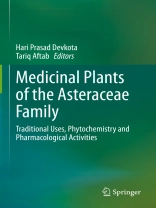This book highlights 12 major plants in the Asteraceae family from the aspects of traditional uses as food and medicine, phytochemistry, and pharmacological activities.
Asteraceae is one of the largest family of flowering plants comprising over 1, 600 plant genera and 32, 000 plant species. Plants belonging to this family have a long history of being used as medicinal plants for the treatment of various diseases. Many of them are also used in the preparation of foods, beverages, and also used in pharmaceutical and cosmetic industries. In addition, plants such as Artemisia annua have played an important role in the discovery of novel drugs.
The book summarizes the traditional uses of the plants in the family Asteraceae and their scientific validation, which helps readers understand their relation and impact on human health. It also explains the Phytochemistry of the species and presents the pharmacological activities and mechanisms in detail. Understanding current scientific knowledge will help in the commercialization of products based on these plants and also helps to find the research gaps that should be fulfilled in the future for their optimal use. It also helps in increasing the awareness of the plant species related to conservation, cultivation, and sustainable utilization. This edited volume comprises chapters contributed by experts from around the world.
Daftar Isi
Chapter 1. An overview of medicinal plants of the Asteraceae family and their impact on human health.- Chapter 2. Artemisia annua L.: Traditional uses, Phytochemistry and Pharmacological activities.- Chapter 3. Artemisia indica Wild.: Ethnobotany, phytochemistry, pharmacological attributes and safety profile.- Chapter 4. Arnica montana L.: Traditional uses, bioactive chemical constituents, and pharmacological activities.- Chapter 5. Aster tataricus L.f.: Ethnomedicinal uses, phytochemistry and pharmacological activities.- Chapter 6.Atractylodes lancea (Thunb.) DC.: Ethnobotany, phytochemistry, pharmacological attributes and safety profile.- Chapter 7. Carthamus tinctorius L.: Traditional uses, phytochemistry and pharmacological activities.- Chapter 8.Chrysanthemum morifolium Ramat.: A Medicinal Plant with Diverse Traditional Uses, Bioactive Constituents, and Pharmacological Activities.- Chapter 9.Crassocephalum crepidioides (Benth.) S.Moore: Traditional uses, chemical constituentsand biological activities.- Chapter 10. Dolomiaea costus (Falc.) Kasana & A. K. Pandey: Ethnomedicinal uses, bioactive chemical constituents and Pharmacological activities.- Chapter 11.Eclipta prostata (L.) L.: Traditional use, phytochemistry and pharmacology.- Chapter 12. Helianthus annuus L.: Traditional uses, phytochemistry and pharmacological activities.- Chapter 13. Silybum marianum (L.) Gaertn.: Traditional uses, phytochemistry and pharmacological activities.
Tentang Penulis
Hari Prasad Devkota
Kumamoto University, Japan
Hari Prasad Devkota currently works as Assistant Professor at Headquarters for Admissions and Education, and Graduate School of Pharmaceutical Sciences, Kumamoto University, Kumamoto, Japan. He completed his Ph D in Pharmaceutical Sciences from Graduate School of Pharmaceutical Sciences, Kumamoto University in 2013. His main research interests are plant-derived bioactive natural products, functional foods and ethnopharmacology. Till now, he has authored more than 150 research articles including original research articles and review articles, 3 books and more than 20 book chapters. He is currently involved as editorial board member of various international journals related to medicinal chemistry, pharmacology and ethnobotany. He also received Kumamoto University Education Award in 2017 and 2019 for his activities related to multidisciplinary education and science communication.
Tariq Aftab Aligarh Muslim University, India
Tariq Aftab received his Ph.D. in the Department of Botany at Aligarh Muslim University, India, and is currently an Assistant Professor there. He is the recipient of a prestigious Leibniz-DAAD fellowship from Germany, Raman Fellowship from the Government of India, and Young Scientist Awards from the State Government of Uttar Pradesh (India) and Government of India. After completing his doctorate, he has worked as Research Fellow at National Bureau of Plant Genetic Resources, New Delhi and as Post-doctorate Fellow at Jamia Hamdard, New Delhi, India. Dr. Aftab also worked as Visiting Scientist at Leibniz Institute of Plant Genetics and Crop Plant Research (IPK), Gatersleben, Germany, and in the Department of Plant Biology, Michigan State University, USA. He has edited 15 books with international publishers, co-authored several book chapters, and published over 80 research papers in peer-reviewed international journals. His research interests include physiological, proteomic, and molecular studies on medicinal and crop plants.












